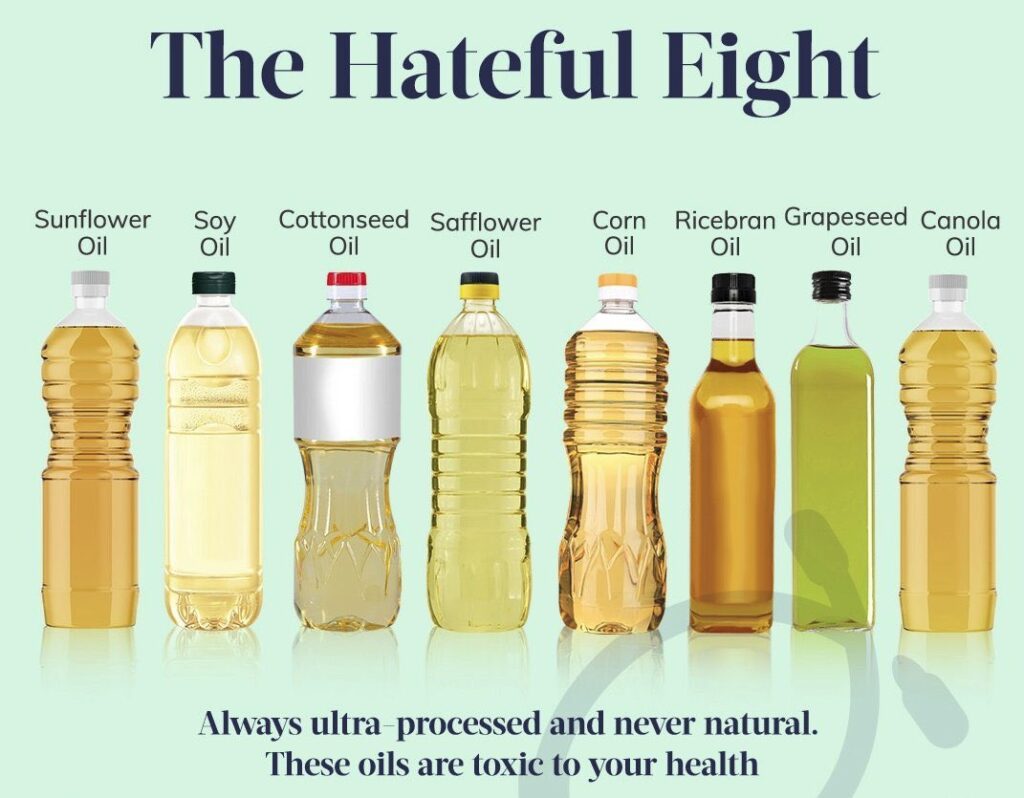Seed oils like canola, soybean, and sunflower may seem harmless, but there are reasons you might want to reconsider using them in your cooking.
One of the biggest concerns is their high omega-6 fatty acid content. While omega-6s aren’t inherently bad, our modern diets often contain too much, leading to inflammation and other health issues.

Another issue with seed oils is the way they’re processed. Most of these oils are highly refined, which means they undergo lots of processing—often involving high heat and chemicals—to make them shelf-stable and clear. This process can strip away nutrients and even create harmful compounds.
Seed oils have unfortunately become a staple in processed foods for their versatility and low cost, making them a common ingredient you might not always notice.
Checking labels at the grocery store can open your eyes to just how often they’re used, so it’s wise to be aware of what you’re consuming.
Read more about how to find them here:
And why to avoid them here:
While it’s easy to just grab a bottle of vegetable oil off the shelf when frying something up, understanding what makes seed oils less desirable is the starting point to healthier cooking choices. Prioritizing better fats in your diet can contribute positively to your health in the long run.
Benefits of Healthier Alternatives

Switching from seed oils to healthier fats can be a game changer in your cooking and overall well-being.
Natural fats like
- butter
- ghee
- lard
- tallow
- coconut oil
- olive oil
- avocado oil
All offer a host of benefits that seed oils don’t.
One of the standout advantages is their stability at high temperatures. This means they’re less likely to break down into harmful compounds when you cook with them, making them much safer for frying, sautéing, or baking.
These alternatives are also more nutrient-dense. For instance, butter is rich in vitamins A, D, and E, while olive oil is packed with antioxidants and heart-friendly fats. These nutrients are crucial because they support everything from vision to cardiovascular health.
Another plus is that these natural fats often come without the harmful additives found in many seed oils. When you’re using organic and unrefined versions, you’re getting a more pure form of fat, which can help you feel better about what you’re putting into your body.
Ditching seed oils for these healthier options can also elevate the taste of your dishes. The flavor profile of butter or coconut oil can add a richness that you just can’t get from canola or sunflower oil. Better-tasting food that’s good for you—that’s a win-win.
How to Start Transitioning

Making the switch from seed oils to healthier fats might feel daunting, but a few simple steps can help ease the transition. The first thing to tackle is reading labels carefully. Seed oils often hide under terms like ‘oil,’ ‘vegetable oil,’ ‘canola oil,’ or ‘partially hydrogenated,’ so getting familiar with these terms will help you spot them quickly.
Next, it’s crucial to give your pantry a makeover.
Stock up on high-quality products like extra virgin olive oil, grass-fed butter, and cold-pressed coconut oil. These choices not only align with healthier cooking but also add a flavorful twist to your meals.
Keep in mind, you don’t have to overhaul everything overnight. Start by replacing seed oils in recipes you make frequently. Whether it’s the oil used in salad dressings or what you fry your morning eggs in, every small change adds up.
Finally, investing in better quality oils can be a game changer for your health and taste buds. Look for organic, unrefined options that guarantee you’re consuming natural, minimally processed fats. This choice not only supports your well-being but can also make cooking more enjoyable.
Best Cooking Applications for Each Replacement

Understanding which fats work best for different cooking methods can enhance not just the taste but also the health value of your meals. Let’s explore how to use natural fats effectively.
- Butter and ghee are incredibly versatile. They’re brilliant for sautéing vegetables, adding a rich flavor depth. Their creamy texture also elevates baked goods, making them perfect for cookies, pastries, or any recipe that needs a little indulgence.
- Tallow and lard are your best allies for frying and roasting. They have high smoke points, which means they won’t burn easily at high temperatures, giving your fried or roasted dishes a perfectly crisp texture without breaking down into unhealthy compounds.
- Olive oil shines when used in cold applications like salads and dressings. It adds a smooth, fruity taste that complements fresh ingredients beautifully. It’s also a good choice for light sautéing but remember to keep the heat moderate to maintain its nutritional quality.
- Coconut oil packs a punch in baking and medium-heat cooking. Its subtle sweetness can enhance everything from cakes to curries. Plus, it’s a handy substitute for recipes calling for a unique tropical twist.
Knowing how to match the right fat with your cooking method isn’t just about following recipes; it’s about experimenting and finding what works for you to elevate your culinary creations to the next level.
Tips for Beginners
Starting small is the key when replacing seed oils with healthier alternatives. Pick one recipe you love and swap the oil out for something like olive oil, tallow, or butter. This way, you’ll gradually get used to the new flavors and textures without overwhelming yourself or your family.
Experimenting with different oils will help you find what suits your taste and recipes best. Each fat has its unique flavor and cooking properties. For instance, try using ghee for a nutty aroma in your stir-fried dishes or coconut oil for a hint of sweetness in baked goods. Don’t be afraid to play around until you find the perfect match for your palate.
Quality is crucial when it comes to oils. Organic and unrefined options might cost a bit more, but they’re worth it. These oils are less processed, retaining more nutrients and natural flavors, which not only benefits your health but can also enhance your culinary efforts.
Storing your oils properly is also important. Keep them in a cool, dark place to prevent them from going rancid too quickly. This ensures that they maintain their flavor and nutritional value, making them last longer so you can cook confidently.
Practical Cooking Tips

Cooking with natural fats can be a breeze if you keep a few practical tips in mind. Knowing the smoke point of each fat is crucial. This is the temperature at which the oil starts to burn and decompose, releasing harmful compounds. For instance, ghee and tallow have high smoke points, making them ideal for frying, while olive oil is better suited for low to medium heat cooking.
Use oils sparingly to make sure they don’t overpower the dish. Natural fats often have richer flavors compared to seed oils, so a little goes a long way. Whether adding butter to your pasta or olive oil to your salad, start with small amounts and adjust to taste. This approach helps in maintaining a balanced and delicious outcome.
Well, maybe not with butter. Add more of that!
Always keep some versatile options like butter or olive oil on hand for quick swaps. These are great all-rounders for a variety of cooking methods and can easily replace seed oils in many recipes. Having them readily available will simplify meal preparation and give you the flexibility to try new recipes or adapt old favorites.
Also, remember to keep butter or oils at the right temperature before using them. For example, using cold butter straight from the fridge might not work well for baking, where softened butter is often required for the right texture.
These tips not only make transitioning easier but also open up a world of healthier and tastier meals. Cooking should be enjoyable and these simple tweaks can help boost both your skills and confidence in the kitchen.
If you’re looking for recipe ideas, Chef Jean-Pierre is my favorite teacher and I can’t recommend his videos enough! Check him out here:
Common Misconceptions

There’s a lot of confusion out there about fats, especially when it comes to saturated fats. One common misconception is that all saturated fats are bad for your health. This idea has led many people to avoid foods rich in natural fats like butter or lard. However, research shows that these fats can be an essential part of a balanced diet when consumed in moderation.
Natural fats, unlike highly processed seed oils, often deliver more nutrients and can help you feel fuller longer. They don’t spike blood sugar levels and can be part of supporting heart health—contrary to old beliefs. It’s essential to look at the quality and source of these fats rather than dismissing them based solely on outdated stereotypes.
There’s also the myth that seed oils are healthier because they’re ‘lighter.’
While they might be marketed that way, their processing often involves high heat and chemicals, stripping away beneficial elements and creating potentially harmful byproducts.
It’s time to rethink the way we view and use fats in our diet. Focusing on quality, minimally processed options is key. Giving natural fats a chance in your kitchen might not only be a healthier choice but could also enhance your culinary experiences.
Understanding these myths and facts helps to make informed decisions about what we consume and how we cook. Education is empowerment—knowing what’s genuinely good for you allows for better choices, leading to a healthier lifestyle overall.
Finding Alternatives

Locating high-quality natural fats doesn’t have to be a chore if you know where to look.
Farmers’ markets are excellent spots to find fresh, locally-produced items like grass-fed butter or locally sourced lard. These options often ensure you’re getting products that are less processed and more flavorful.
Go talk to your local butcher, they may even give you some fat trimmings for free and you can render your own tallow!
Online shopping offers another convenient route. Specialty stores focused on healthy cooking ingredients make it easy to stock up on anything from extra virgin olive oil to organic coconut oil, really anything you can think of. These vendors often provide detailed sourcing information, so you know exactly what you’re buying.
When looking for brands, choose ones known for quality and transparency. Opt for companies that prioritize sustainable practices and minimal processing. Reading customer reviews and checking product certifications can guide your purchasing decisions.
Local health food stores can also be treasure troves for natural fats. The staff there is usually knowledgeable about their products and can assist with selecting the best options for your needs. Plus, buying in smaller, local shops often supports community businesses.
Ultimately, being resourceful and informed makes it easier and more enjoyable to transition to healthier cooking. Exploring different sources for natural fats not only broadens your culinary horizons but can also contribute to more nutritious and rewarding meals.
Anything you do to consume less machine lubricants (AKA seed oils) the better!
Thank you for reading!





Growing up in an Asian household, we canola oil to cook everything. But after discovering the evils of seed oil, I learned to substitute canola oil with butter when making fried rice. I saw a Japanese chef do this and gave it a try and it tasted way better! But there’s other asian dishes that just wouldn’t work with butter. Do you think that avocado oil would be the best neutral-tasting option?
Ooooo yes avocado oil is a great substitute for anything you’re frying! Also tallow is neutral and would go well with food from any side of the earth. For fried rice, try adding a little sesame oil in with the butter for extra flavor. Thanks for reading!!